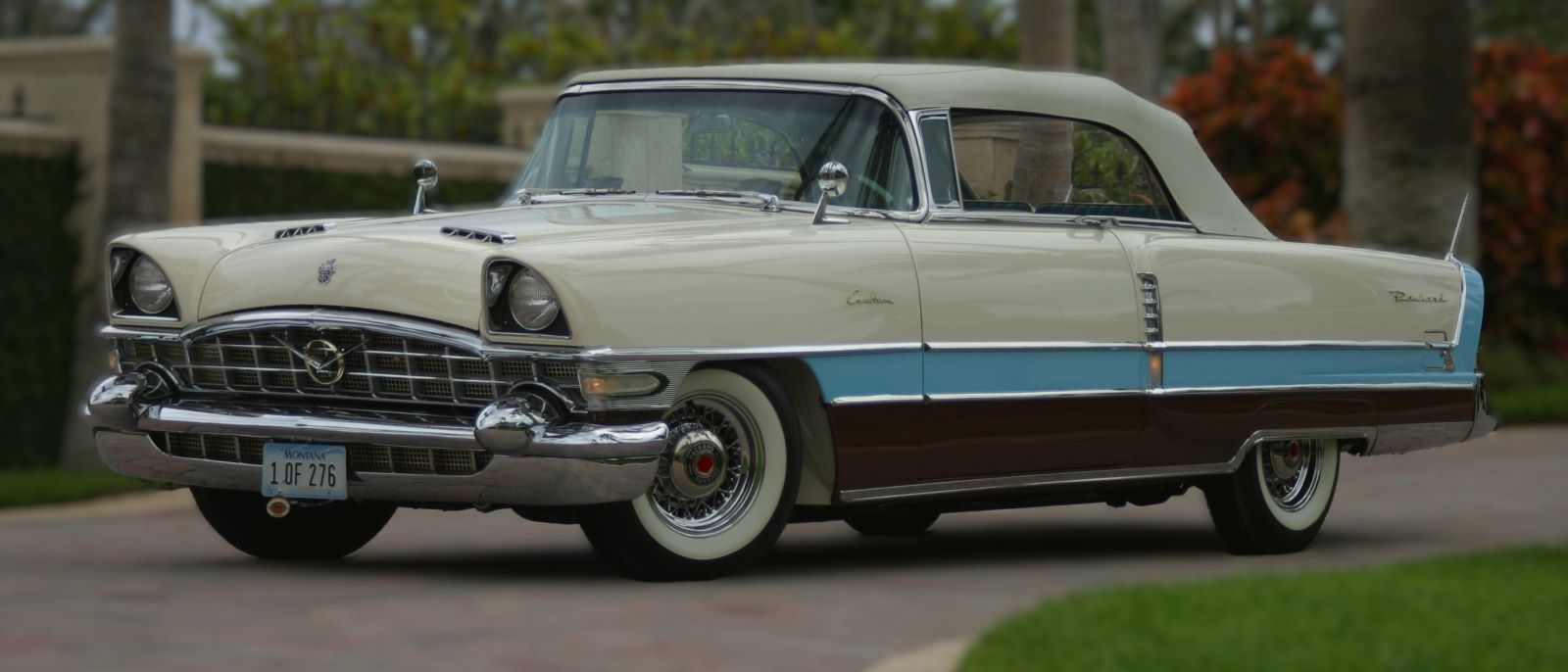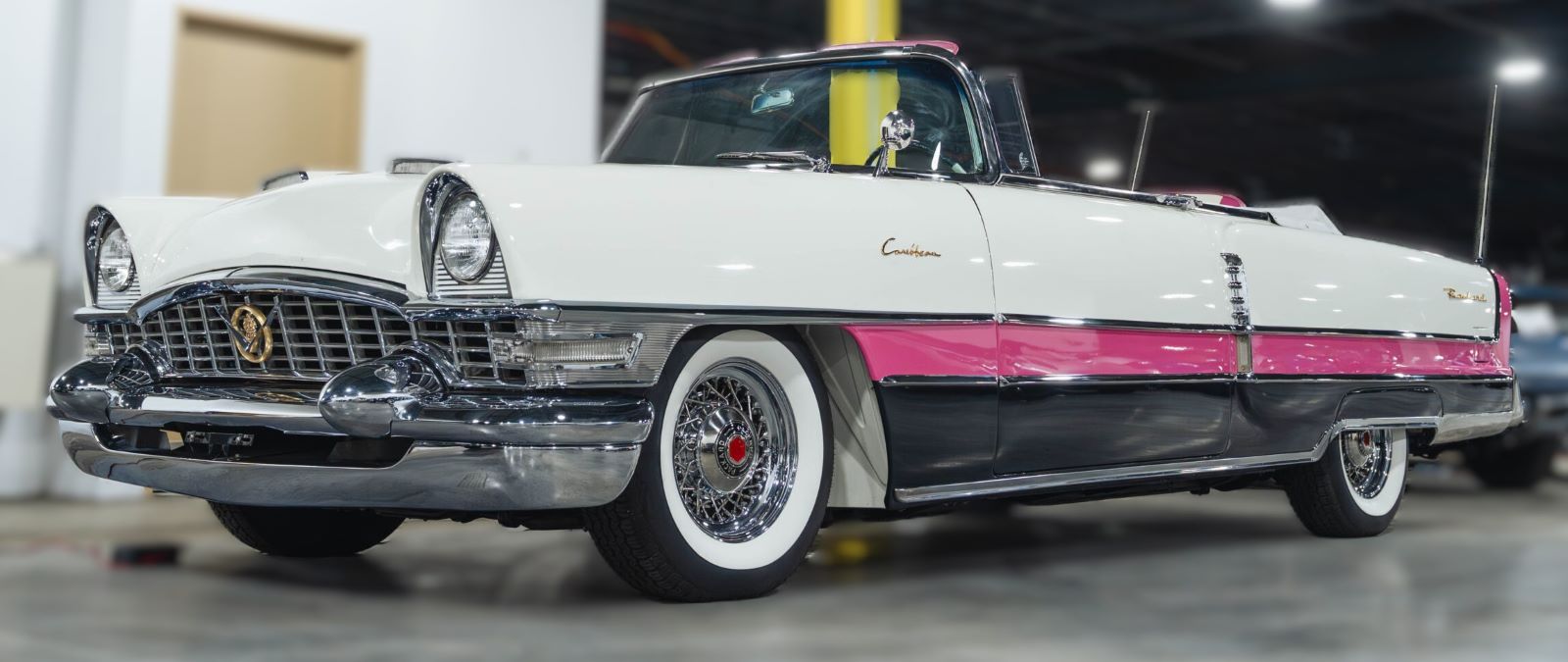
The Packard Caribbean is one of the most iconic American luxury cars of the 1950s — a true statement car from a company trying to reclaim its status at the top of the luxury market. The Caribbean was Packard’s answer to Cadillac Eldorado and Lincoln Continental — an exclusive, hand-built luxury cruiser. Sadly, Packard was struggling financially, and by 1956 they were merging with Studebaker. The Caribbean was one of the last great true Packards before the brand effectively disappeared.
- First introduced: 1953
- Built by: Packard Motor Car Company (Detroit, Michigan)
- Production years: 1953–1956
- Body style: Originally a convertible, later available as a hardtop too
- Design influence: The 1953 show car “Pan American,” styled by Richard Teague, led to the Caribbean’s design. It had clean, European-style lines with minimal chrome compared to the heavy American norm.
Key features by year:
- 1953 Caribbean: Essentially a heavily customized Packard Convertible with special body panels, limited chrome trim, and unique full wheel covers. Only 750 were built — extremely rare.
- 1954 Caribbean: Mild facelift. Now offered a choice of colors, still hand-finished. Had more luxury touches like leather interiors.

1955 Packard Caribbean
- 1955 Caribbean: Major change — now on Packard’s new redesigned bodies. Available as a convertible and a two-door hardtop coupe for the first time. Introduced Packard’s new overhead-valve V8 engine (352 cubic inches, ~275 hp), plus a standard push-button electric leveling torsion bar suspension (very advanced).
The 1955 Packard Caribbean was Packard’s luxury performance convertible, produced during the final years of the company’s independent operations. Introduced in 1953 and redesigned by 1956, the Caribbean represented the best of what Packard had to offer—elegance, innovation, and exclusivity. Only 276 convertibles were built in 1956, making it one of the rarest American classics from the era.
This show-stopping convertible was known for its eye-catching tri-tone paint scheme, massive chrome bumpers, and a wealth of forward-thinking features, including a self-leveling torsion bar suspension system and push-button Ultramatic transmission. With its powerful V8 engine and luxurious interior, the Caribbean offered a unique blend of performance and sophistication, showcasing Packard’s final effort to maintain its status among the American elite.
1956 Packard Caribbean
- 1956 Caribbean: Even flashier. Tri-tone paint schemes were offered. Power was up to around 310 hp from a 374 cubic inch V8. Only 276 convertibles and 263 hardtops were made in ’56 — very rare and collectible.
The 1956 Packard Caribbean was one of the most luxurious and distinctive models produced by the Packard Motor Car Company. It was part of the final years of Packard’s independent existence before its merger with Studebaker.
The 1956 Caribbean featured a powerful 374-cubic inch V8 engine, delivering 310 horsepower, which was a significant amount of power for the era. It was paired with an Ultramatic automatic transmission. This model was equipped with Packard’s innovative Torsion-Level suspension system, which provided a smoother ride by automatically adjusting the suspension based on road conditions and passenger weight distribution.
The Caribbean had a striking two-tone or three-tone paint scheme, making it visually distinctive. It featured a sleek, low-slung body with an extended front hood and Packard’s signature chrome grille. The car was offered as both a convertible and a hardtop coupe, making it appealing to luxury car enthusiasts.
The interior was plush, featuring high-quality materials such as leather upholstery, power seats, and advanced controls for comfort and convenience, underscoring Packard’s reputation for luxury.
With fewer than 500 units produced in 1956 (276 convertibles and 263 hardtops) The 1956 Caribbean marked the last year the model was produced under the Packard name before the merger with Studebaker, making it a historically significant vehicle in the brand’s lineup.

You must be logged in to post a comment.